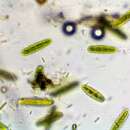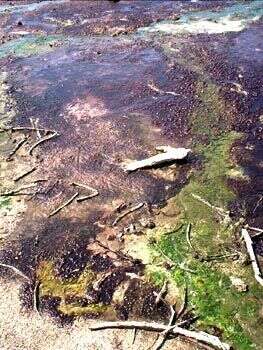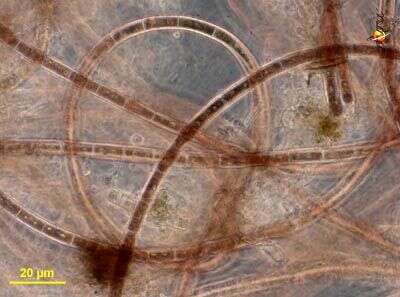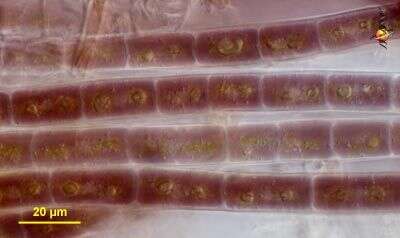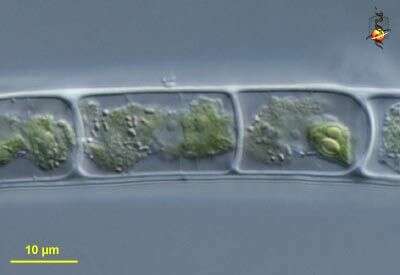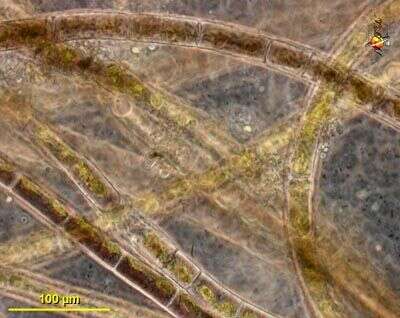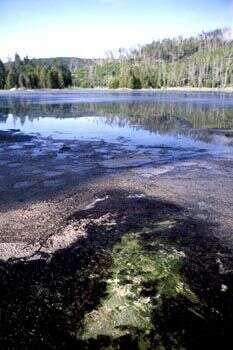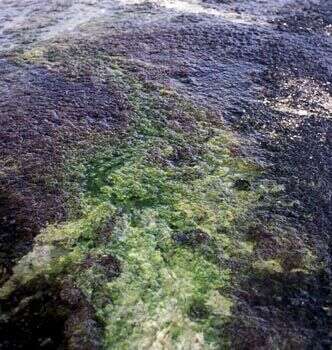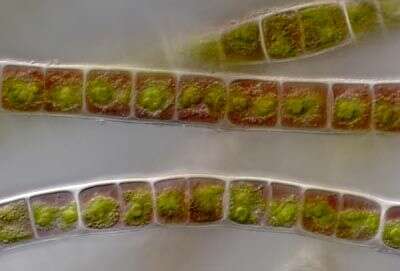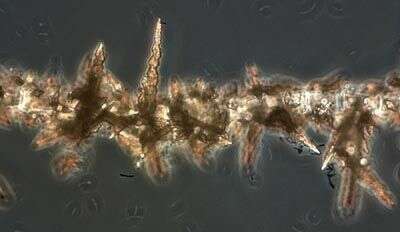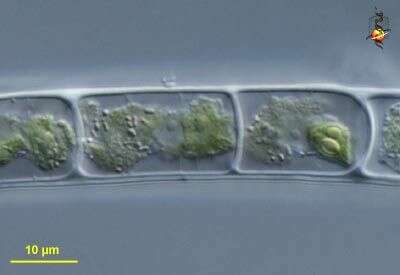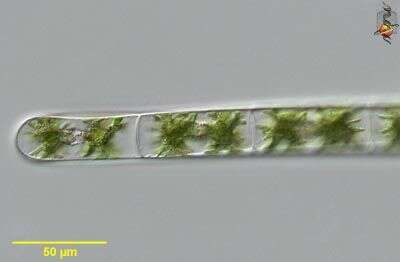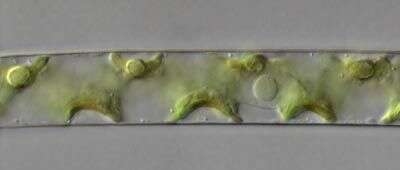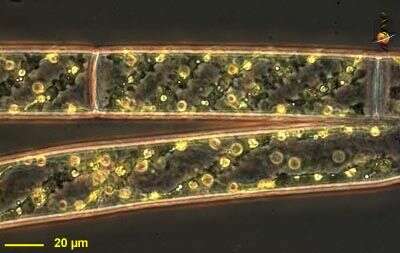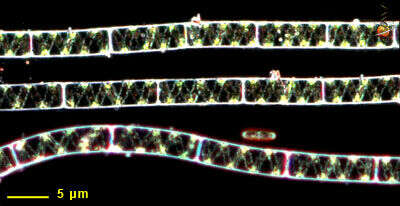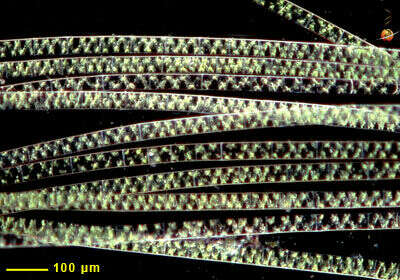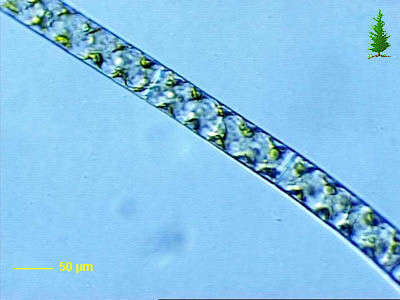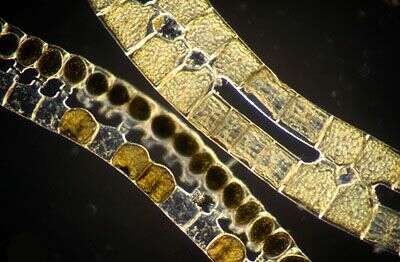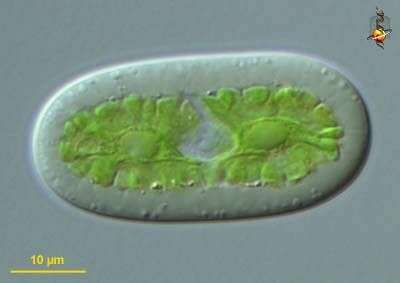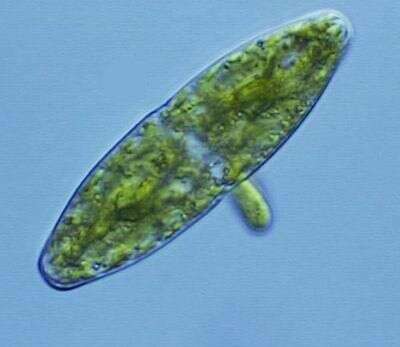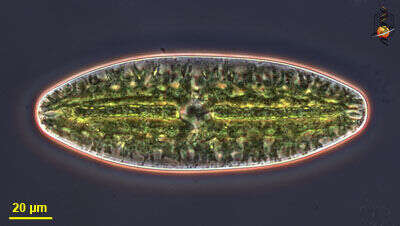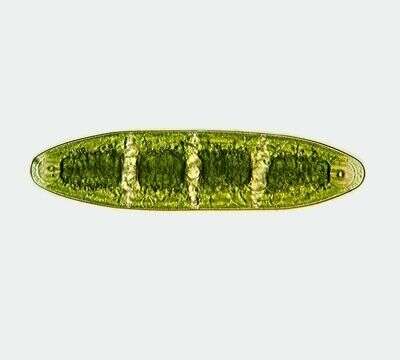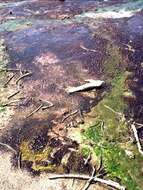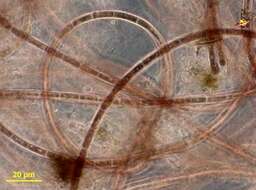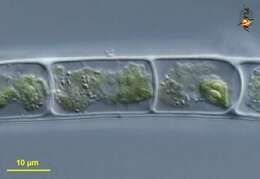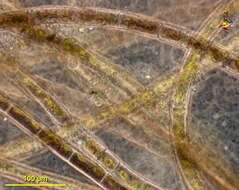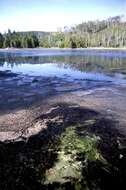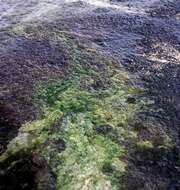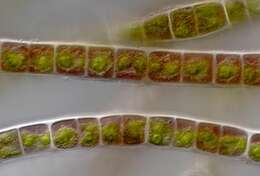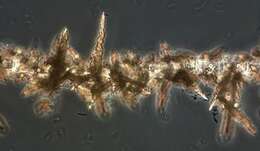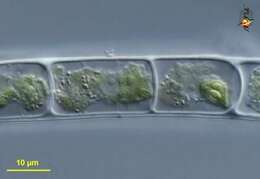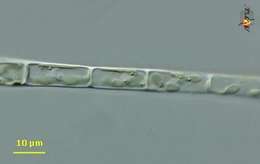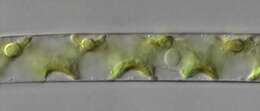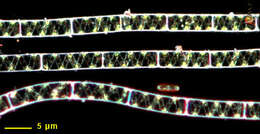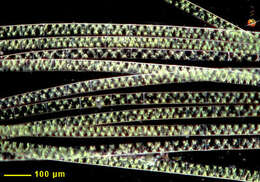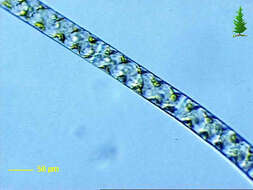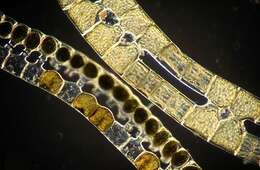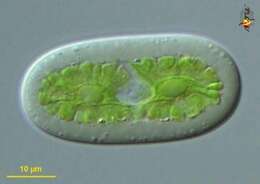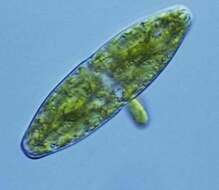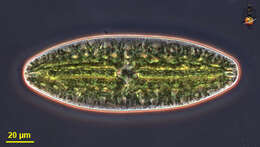-
Zygogonium (sigh-go-go-knee-um) a green filamentous alga, in which cells exposed to intense sunlight accumulate a soluble purple pigment formed from an iron-tannin complex within their cells. In the field, the alga forms a dark purple and green mat on the surface of the mud. Material from Nymph Lake, a thermal site in Yellowstone National Park, photograph by Kathy Sheehan and David Patterson.
-
Zygogonium (sigh-go-go-knee-um) a green filamentous alga, in which cells exposed to intense sunlight accumulate a soluble purple pigment formed from an iron-tannin complex within their cells. These filaments are heavily pigmented. Phase contrast. Material from Nymph Creek and Nymph Lake, thermal sites in Yellowstone National Park, photograph by Kathy Sheehan and David Patterson.
-
Zygogonium (sigh-go-go-knee-um) a green filamentous alga, in which cells exposed to intense sunlight accumulate a soluble purple pigment formed from an iron-tannin complex within their cells. These cells are heavily pigmented. Differential interference contrast. Material from Nymph Creek and Nymph Lake, thermal sites in Yellowstone National Park, photograph by Kathy Sheehan and David Patterson.
-
Zygogonium (sigh-go-go-knee-um) a green filamentous alga, in which cells exposed to intense sunlight accumulate a soluble purple pigment formed from an iron-tannin complex within their cells. This image shows the appearance of the plastids within the cells and the central nucleus is also evident. Differential interference contrast. Material from Nymph Creek and Nymph Lake, thermal sites in Yellowstone National Park, photograph by Kathy Sheehan and David Patterson.
-
Zygogonium (sigh-go-go-knee-um) a green filamentous alga, in which cells exposed to intense sunlight accumulate a soluble purple pigment formed from an iron-tannin complex within their cells. Some filaments here look green, others look purple. Phase contrast. Material from Nymph Creek and Nymph Lake, thermal sites in Yellowstone National Park, photograph by Kathy Sheehan and David Patterson.
-
In the cooler areas around the shore of Nymph Lake, the alga Zygogonium forms dark-red, leathery mats. Although Zygogonium tolerates very acid conditions, it cannot survive temperatures above about 35 degrees C. Image by Brett Leigh Dicks.
-
A Zygogonium mat at Nymph Lake. Although this is a green alga, much of the mat is dark maroon and has an almost leathery appearance. Image by Brett Leigh Dicks.
-
Detail of a Zygogonium filament showing the green chloroplasts within the red vacuoles.
-
A filament of Zygogonium is encrusted with bi-pyramidal crystals of sulfur. The alga acts as a physical structure that is able to initiate crystallization. A number of rod-shaped bacteria are closely associated with these deposits.
-
-
Mougeotia (moo-gee-oh-she-a) a filamentous green alga. With cellulosic cell walls and chloroplasts containing chlorophylls a and b. Differential interference contrast.
-
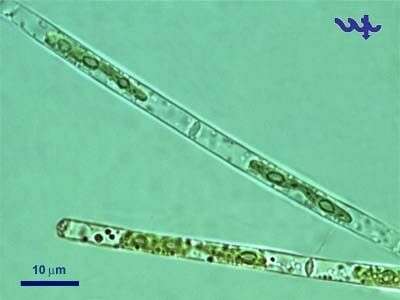
Debarya sp. (Chlorophyta, Zygnematales) is a filamentous green algal that invaded Lake Kinneret in 1998. It blooms in the spring of years when Peridinium gatunense fails to bloom. At the moment, we have never seen conjugation taking place and therefore can not identify it to species level and also are not sure that this is Debarya rather than Mougeotia sp. The genus Debarya is rare worldwide, but was common in geological times as can be found in sediment samples. Genus description (from AlgaBase): Thalli unbranched, forming extensive skeins of intertwining uniseriate filaments. Cells cylindrical 6-30 µm in diameter, several times as long; cell wall two-layered with inner cellulose, outer mucilage layer; endwalls plane; no flagellated stages. Cells uninucleate; chloroplasts axile; flat ribbonlike or platelike; one or two per cell; pyrenoids in row or scattered. Asexual reproduction by fragmentation, akinetes, parthenospores, and aplanospores. Life cycle haplobiontic, meiosis zygotic. Sexual reproduction by scalriform conjugation; gametes isogamous, fuse within conjugation tube. Zygospores distinctly tricarinate with three keels, or sharp edges. Filaments usually found as free-floating masses. All species rare, but collected from Eruope, Asia, North America, and New Zealand. Earliest fossil zygospores reported from Permian Period (250 million years b.p.); in contrast to modern distribution, fossil keeled spores quite common in sediments where Zygnemataceae found, especially in cold or cool climates in high-mountain treeless plains (paramos) of Colombian Andes; used as marker for clean, oxygen-rich, shallow stagnant, mesotrophic water in habitats subject to seasonal warming. Originally D. glyptosperma described as a species of Mougeotia; Debarya may be related to latter. Trait of conjugation places in Zygnematales but otherwise phylogenetic position unclear.
-
Zygnema, filamentous green algae with star shaped chloroplasts. Enclosed in cellulosic cell wall. Each plastid contains a pyrenoid. Nucleus lies between plastids. Differential interference contrast.
-
In Spyrogyra, the plastids (a type of chloroplast) are spiral around the interior of the cell. The nucleus is slightly to the right of the center. This alga was collected from the Gardner River near Sheepeater Cliffs.
-
Spirogyra observed in freshwater sediments in the vicinity of Broome, Western Australia in September 2003. This image was taken using phase contrast optics. This work was supported by the Australian Biological Resources Study.
-
Dark ground illumination of this filamentous green alga. The chloroplasts are ribbon-like and spiral around the interior of the cell wall.
-
Small clump of filaments with spiral plastids viewed using dark-ground illumination.
-
Collected from Cumloden Swamp on October 7, 2002.
-
Dark ground image of preserved filaments showing various stages of the conjugation process. Paired filaments caught during conjugation are above, filaments with zygotes are below.
-
Netrium (knee-tree-um) a simple desmid cell - a type of green alga having, like other green algae, a cellulosic cell wall and chloroplasts with chlorophyll B. Although a desmid, without the more usual mirror-image form. Central nucleus and two flat crenulated plastids. The similar Cylindrocystis differs because it has star-shaped plastids. Differential interference contrast.
-
Differential interference contrast.
-
Phase contrast image of this desmid.
-
Netrium interruptum (BREB.) LÃTKEM. The cells are 4-5 times longer than wide. The central part is cylindrical and gradually converging towards the broadly rounded off ends. The terminating vacuoles are big with a spherical crystal each. The chromatophores are clearly partitioned in four segments. Dimension: Length 200 â 350 µm, width 30 â 70 µm Ecology: Sporadic in little acidic fens and bogs, in addition, in the plankton of oligotrophic lakes. Occurrence: Ubiquitous, apart from Australia

